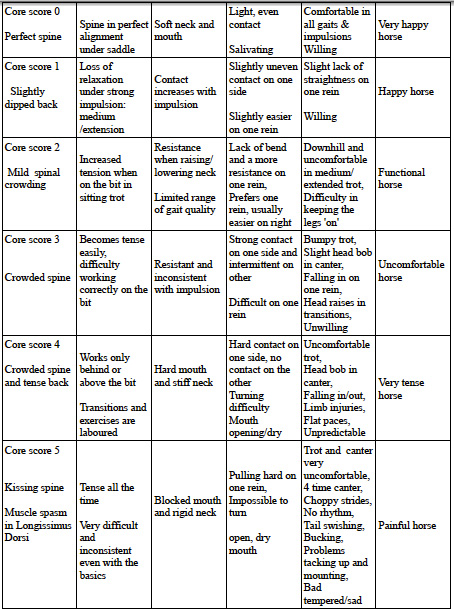Core Strengthening Exercises… For Your Horse!
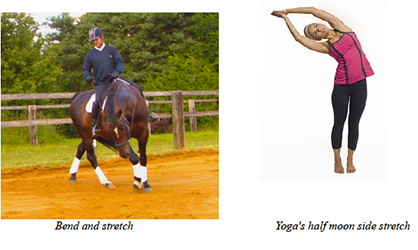 An Introduction to Core Correction
An Introduction to Core Correction
A ridden method to strengthen your horse’s core muscles to improve gaits, engagement and alleviate Spinal Crowding Syndrome/KSD
by: Visconte Simon Cocozza
The pursuit of mental and physical harmony with our horses has to be the ultimate riding goal. That is where the magic happens. Our traditional training methods aim to build a horse’s muscles, reactions and fitness to power him when jumping over things, galloping fast or performing impressive dressage movements. There are, though, key muscles deep within our horses that can remain weak in even very fit horses making it impossible for them to work with core fluidity, leading to self-restraint and in some cases, pain.
A clue to the origin of a disconnected ride are the symptoms we encounter when we are aboard. Over the years it has become obvious that whatever the build, breed, discipline or even history, the same groups of resistances are experienced by most horses and their riders, only intensity varies. Bad backs are often disguised as schooling issues until they become severe enough to easily identify.
Core weakness shows itself initially with a heavy, onesided contact amongst other all too familiar resistances and can indicate the onset of ‘Spinal Crowding Syndrome’ (SCS), which is extremely common and overlooked. Unfortunately, if not addressed, it can ultimately lead to a ‘Kissing Spine.’
‘Core Correction’ is a ridden system of Yoga for horses. By precisely targeting, reversing, then strengthening this inherent weakness under the guidance of the rider, the pair can together develop a permanent understanding of what improved self carriage feels like and what to do about it.
What is Spinal crowding syndrome?
Spinal Crowding Syndrome is a precise term for the complications of a hollow back and can be slight to severe. Evolution has perfected the horse’s skeleton over millions of years to make him/her a great mover, but it did not make the horse’s back naturally strong enough to carry a human, however big and strong they appear.
When a young horse first carries a rider, the new weight placed over the middle of his spinal column causes it to slump, or dip slightly. This is of course invisible to the eye due to the presence of a saddle.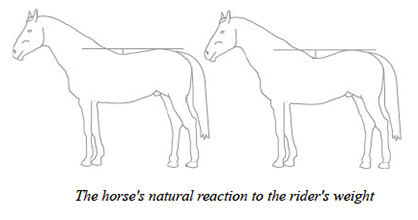
This closes the already narrow gaps between the vertical spinous processes of the thoracic vertebrae. As his work progresses into trot and canter, he can begin to feel discomfort as the nerves running between the processes risk becoming rubbed and if not corrected, pinched.
To limit discomfort as training becomes more demanding, the horse will instinctively tense his back muscles and ‘lock’ the area, to limit the rubbing action. As horses are creatures of habit, once this defense begins, it is likely to continue, and he loses the natural flexible qualities of his spine that are key to the elastic connection of his large body sections. As he is asked to perform more trot and canter work, he responds as best he can by using his limbs instead of his whole body, deliberately avoiding bending through the spine by triangulating the gait and swinging the quarters to the inside. It is for this reason so many well bred horses are uncomfortable, never seem to fulfill their actual potential, irrespective to their level of fitness, and why most horses move well in the field yet lose their natural cadence under saddle.
The weak link
There is a complex system of muscles that run under the spine called the Multifidus System. These are the body’s ‘core’ muscles and need to be strong and short to counteract spinal dipping and keep the gaps between the processes open when carrying the rider.
Simply asking the horse for more forward effort in an effort to engage the quarters will not build the Multifidus system, particularly if the spine has learned already to dip as the horse is working against himself. In fact, more impulsion worsens the problem.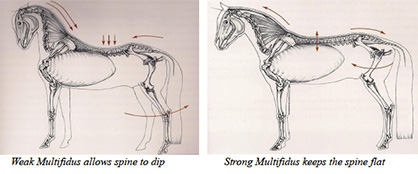
When our horses become more mature and we ask for work in a more advanced outline, the muscles over the spine can become very tense as they further attempt to defend the spine from the potentially uncomfortable twisting of an active gait, while the increased impulsion and muscular tension creates a critical counter force leading to further compressions of the processes.
Some horses stabilize and learn to work like this, by becoming sufficiently supple in the limb joints, although their gaits will be incurably crooked, one-sided and limited. In some cases, horses experiencing this syndrome develop very tense back muscles leading to severe behavioral and riding resistances. At that stage it has possibly become a ‘kissing spine’ where the vertebrae have become kinked by the strong Longissimus Dorsi muscles in spasm, where the processes are touching and crushing the nerve.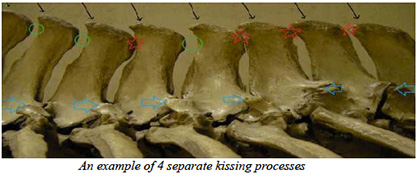
A secondary effect of the spine losing elasticity is that kinetic force is thrown forwards towards the shoulders as it can no longer be absorbed through the horse’s center. This pushes the lowest part of the cervical section of his spine, the base of the neck, downwards between his shoulder blades and robbing him of forehand ‘suspension,’ plunging him downhill, onto the forehand and heavily into the rider’s hand making straightness and balance physically impossible.
It is likely that advanced cases may have spinal interference in the C6,C7,T1 which contribute to the bracing resistance found in the rein contact of affected horses.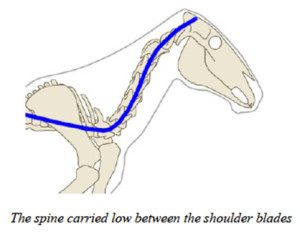
How to tell if a horse has spinal crowding
In motion, our bodies are just a biological mechanism, a machine for moving around. As with any machine, the angles that forces travel must be carefully aligned. A car with a flat tire will pull heavily to that side, for example. Any mechanical misalignment will wear parts quickly due to the excess strain put upon them.
When the horses spine, or ‘chassis’ is misaligned, all the subtle dynamics of limb flight and joint trajectories are thrown out of line causing all sorts of imbalances, restrictions and excesses. As difficult as it is for the horse to do as asked under these circumstances, things are almost as awkward the rider who is severely jiggled about or even downright ejected, unable to ride in a soft, light way and therefore reinforcing the horse’s tension. Our aids then become impossible for the horse to understand creating a vicious circle of defensive tension that is tricky to break.
As horses are generous and silent triers, they don’t yelp in pain like people or other pets, making the initial signs of spinal crowding hard to notice. The signs are often seen as individual problems with no common cause, but they do have telltale predictability.
As spinal crowding symptoms come in groups, we can start by giving each horse a ‘Core score’. If we were to ride a horse and score his way of going on a scale of 0 to 5, where a 0 is a faultless, free and strong spine and a 5 score is a painful kissing spine, here is a table of symptoms as a guide.
Secondary effects
When any machine has dynamic misalignments, individual parts will be asked to support a different kind of strain than that for which they were designed. Unfortunately, the secondary effects of spinal crowding will show excessive strain in the area most used by the horse to compensate for avoiding his back correctly, and this often appears in the limbs as a seemingly unrelated problem.
Hoof flares are a good example. The ‘sway’ of hoof growth on one side of the foot shows a repetitive lateral slide of that limb, like a car tire under cornering. As with a tire when cornering, lateral force distorts growth of the pliable hoof, The presence of forces from a direction which the limb was not designed can form all manner of reaction over time. Bony growths, joint swellings, self interference and excessive wear show that a body part has endured excessive repetitive strain. By correcting the horse’s core strength, these ailments and injuries tend to diminish, heal or disappear altogether.
Core Correction – What can you do
If we want our horses to dance, we must train them as we do a human athlete. Continuous analysis of human training methods has us concentrate upon core suppleness and strength before adding power and speed. With human athletes we discovered long ago that the core must be in excellent condition or peak, painless performance will never be achieved. Due to the presence of spinal processes in the horse added to the fact that he has to carry a rider, the condition of a horse’s spinal supporting mechanism are even more critical.
If a Grand Prix Dressage performance is comparable to a Ballet, then it is obvious that the traditional practice of a walk, trot and canter on a loose rein both ways is simply not enough to properly condition a horse for movements that require a high level of balance, suppleness and flexibility, as it will just loosen the legs. The whole body must be trained, weak areas made strong and then what was difficult becomes easy, beautiful and sustainable.
Core Correction takes human body conditioning disciplines such as Yoga, Pilates and recent developments in kinetic chain sports training, and applies these principles to the horse’s weak areas with the same philosophy of controlled, progressive strength building movements under saddle. As the exercises are performed in partnership with the rider, this not only produces the physical conditioning and confidence that the horse needs but also dramatically develops the psychological and physical bond between the partners to make advanced work possible and more harmonious.
There are four distinct elements to keep in mind with this method. Understanding them guides our decisions of when to continue, when to stop and when to move on.
STRETCH – to elongate the muscles and spine, relieving pressures and increasing motion range
TRUST – build confidence in his own body to bend freely under our seat without self restraint
STRENGTH – to build the core muscles and peripheral joints to move fully and freely
EDUCATION – to teach the horse to permit us to control this new freedom with our aids
Exercises – The Stretching
Below are four introductory exercises that look quite simple, and in a sense they are, yet they will produce a noticeable improvement in the horse’s willingness to flex through the spine. They combine stretch and twist motions at low speed that break down the defensive ‘locking’ habit of the back, to encourage the horse to learn to let go and allow progress to the strength building phase of exercises that will develop true engagement under impulsion (see part 2, Core Correction – Advanced).
The movements should be repeated slowly and deliberately until fluid and easy, in a similar way as a pianist would repeat the scales to perfection. As SCS is in part a psychological defence the effect is not only a strengthening of the horse’s core but also to practicing the basic ‘language’ of movement between horse and rider that will increase ease in a performance by developing trust at the same time as strength.
To be performed initially from walk and repeated until the horse feels more fluid before moving onto the daily program. The human Yoga version is pictured which has the same effect on our bodies as it does on the horse.
1. Inside ‘Half Moon’ bend and stretch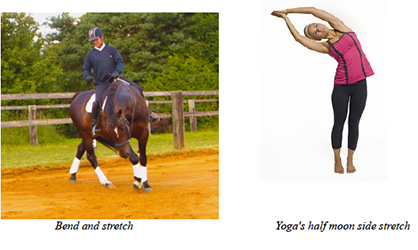
Quite simply a small circle around a cone or block in walk, with long reins and lots of inside bend. This stretches the outside of the body and helps the horse to let go of his lateral back tension. Don’t insist, encourage. Relax, wait and repeat until his head drops and he bends more freely and regularly.
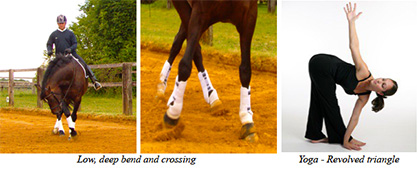 2. Leg yield ‘Triangle’ stretch in walk
2. Leg yield ‘Triangle’ stretch in walk
As with the revolved triangle for people, a stretched leg yield encourages the hips to rotate in the opposite direction from the shoulders, encouraging the spine to twist freely and gradually release its kinks. The horse may initially block himself. Persist sympathetically and he will let go, drop his head willingly to the inside rein and step sideways with more and more elasticity.
3. ¼ to full turn about the forehand – The ‘Half Split’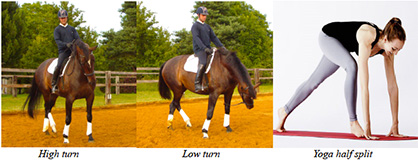
Great for opening gates and even better for building the Multifidus system. This exercise works on many levels and when perfected later on, the horse will work in a very fluid outline. It teaches the horse to move away from a light inside leg which is the basis of straightness control, lateral work and precise cornering later on. It also builds the lateral and rotative pelvic control muscles, as well as simultaneously lifting the spine and separating the processes to relieve impinged nerves.
Get one or two correct steps before asking for more. The horse must step under his body with the inside hind and rotate his quarters around the inside fore. Back up the inside leg with a gentle whip aid to get the first steps and watch out for evasions such as stepping backwards and walking out of the outside shoulder. When the horse easily drops the inside rein to you and willingly gives the outside rein a contact, the correction has been made.
4. ¼ to ½ Pirouette – Turn about the haunches to ‘Thread the Needle’
This is essential for suppleness in the shoulders and rider/horse communication. From standstill with an open reined inside bend, increase the outside rein pressure until the horse steps away from the aid. This develops thoracic sling motion range, encouraging the horse to carry his spine higher between his shoulder blades. This raises his center of gravity and gives him the ability to push his front end upwards in each stride making his movement ‘uphill’ and supple, and allowing a space for his rear end to engage into.
The result is light outside rein influence of the shoulder, allowing precision turns and the key to easily controlled shoulder in, half-pass and pirouette.
When beginning this work, the rider must think of a gentle, suppling guidance as the resistances are a combination of psychological as well as physical. Great care needs to be taken to ask for more effort and strength only after the horse has let go of his defenses.
Top tips:
1. Long and low will stretch the horse but when you have an improvement, do the exercise at least once ‘on the bit.’
2. Try to keep your weight in the saddle and stirrups always even sided whatever is going on.
3. If you can’t sit to the trot or canter, don’t. Use the exercises to get more spinal freedom and then try later when the gait feels smoother.
4. When bending the horse never pull the rein, only ever hold steady at the angle you want and wait till the horse gives to the rein in response to the leg. When he wants to drop his head and stretch out, let him.
5. You and your horse need understand each other very well in order to bond and become one. If you feel that you can do a bit more, try it and let your horse be your guide.
6. A core score 0 horse will walk, trot and canter in balance with his nose very near the sand the moment you fully give the reins. This is your goal.
7. These exercises encourage legs to cross. Boot up!
8. Every training session is a fresh beginning and it is never too late for a horse and rider to put the past in the past.
When you have felt the improvements brought about by mastering these simple exercises, move onto the more demanding ‘Core Correction – Advanced’ movements that encourage the individual’ full range of motion combined with impulsion.
Conclusion
When a horse has achieved a core score 0, then we can choose a preferred method of equitation whether it be Podhajsky, De La Gueriniere, Savoie, The Scales, etc. The horse will now be in the physical condition of those that these principles were developed to apply. One must remember the circumstances under which they were written are not those of today’s equine marketplace.
With horses that core scores a 4 or 5, the first advice to seek is from your Vet. A lateral thoracic x-ray will show immediately if there is any crowding or kissing. Depending on the severity there are a few options, which are traditionally surgical and/or anti-inflammatory medication. My preference as a trainer is to retrain the Multifidus system to eliminate the original cause of the misalignment rather than alleviate the symptoms. When done carefully, even very severe cases have been reversed with this method.
Well, my friends, I hope these words are interesting and of use. Please don’t hesitate to contact me if you have problems, breakthroughs or wish to go further with this method and please, never forget that the gentle willingness of horses is their most precious quality and the one most loved by us humans. If we truly want to bond in motion with these creatures, we must reciprocate by recognizing the silent signals of difficulty that are hidden by their innocent generosity.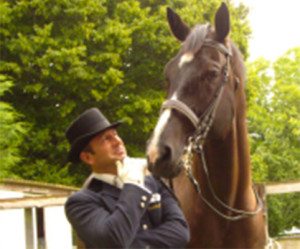
May the horse be with you.
Visconte Cocozza
Email: quadriapony@aol.com
Written with the assistance of:
1. Dr.Richard Coomer, (Kissing Spines FAQ), Cotts Equine Hospital
2. J.M. Denioux et J.P. Pailloux – Kinésithérapie du Cheval – Deuxième édition 2005
3.Walmsley JP, Pettersson H, Winberg F, et al: Impingement of the dorsal spinous processes in two hundred and fifteen horses: case selection, surgical technique and results. Equine Vet J 34:23 – 28, 2002.
4. Basisafrichting – Relatieve oprichting verus absolute oprichting 2003
© 2014











